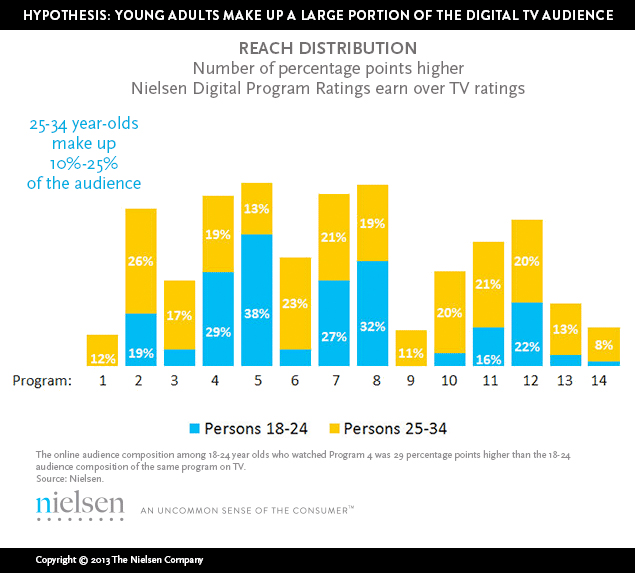Scientific Method: What we learned from Nielsen’s Pilot of Digital Ratings [INSIGHT]
October 15, 2013
![]() By Eric Solomon, SVP Global Digital Audience Measurement
By Eric Solomon, SVP Global Digital Audience Measurement
Like a lot of kids, growing up, I was convinced that much of what I was taught in school would prove to be of little use to me as an adult. And while my younger self wasn’t totally wrong—I’ve yet to reference the atomic mass of Tungsten in conversation—much of what I learned at a young age are concepts and principles that I still draw from all these years later.
I was reminded of this truth this fall, when my oldest daughter started learning about the scientific method: the process of forming questions and a hypothesis, using measurement and observation to test these, and analyzing the results.
Earlier this year, Nielsen started its own scientific inquiry with the Digital Program Ratings pilot, and we had two main hypotheses to test:
1.) Program audience should be predictive of campaign audience—in other words, by using the same measurement methodology as we do for Nielsen Online Campaign Ratings (OCR), our Digital Program Ratings (DPR) data should provide audience composition numbers that can be used to forecast campaign audiences.
2.) Program audiences are likely to skew younger online than on TV. While there may be differences among gender breakdowns across devices, digital consumption remains a younger person’s activity. Should we see this shift at an individual show level, we would be confident that the digital numbers are correct.
So we had two comparisons—one between the audiences for programming content and the audiences for associated online advertising campaigns, and one comparing a program’s traditional TV audience with those viewing the show online. So how did we test these hypotheses?
Testing our hypothesis
Between May and July, nine broadcast and cable networks participated in our pilot. Each client selected two shows that they made available online via their websites, and we measured the program audience for each during the pilot period. We reported the data overnight data to clients and we worked them on the analysis.
The findings validated our hypotheses: when compared with demographic stats reported in OCR, the results for program ratings were closely aligned. And when compared with TV, we found that the audiences matched genders and did indeed skew younger. From these results, we concluded that we are on the right track: our methodology can be used to measure online TV programs with comparability to both OCR and TV. When coupled with Nielsen OCR, these digital measurements can be comparable to Nielsen’s traditional TV ratings, giving broadcasters and advertisers cross-platform measurement tools for both programs and ad campaigns.
Analyzing our findings and drawing conclusions
Among digital TV viewers aged 25 to 34 years old, young adults composed significantly more of the audience watching TV programs online than other groups–between 10 to 25 percent. Interestingly, when we talked with our pilot participants about their expectations for individual shows, we also found in the pilot is that digital viewing is not exclusively a young adult phenomenon. Among men aged 25-54 (myself perhaps included) about half the programs viewed online had larger audience compositions compared to linear TV viewers in this demo group. If you think about it, you start to realize that digital TV isn’t just for kids: there are audiences to be served on digital platforms, and it’s across all ages and genders.
Just as in the classroom, the findings from this study set a new level of understanding we can all learn from, but also raise new questions that will require continued research. My latest hypothesis: as Nielsen rolls out DPR, and as the prevalence of digital distribution increases, I expect to see digital viewing increase among mainstream viewers.































